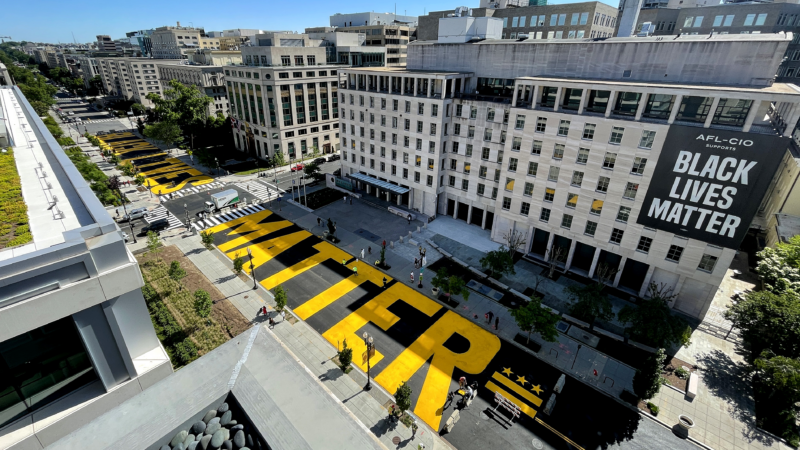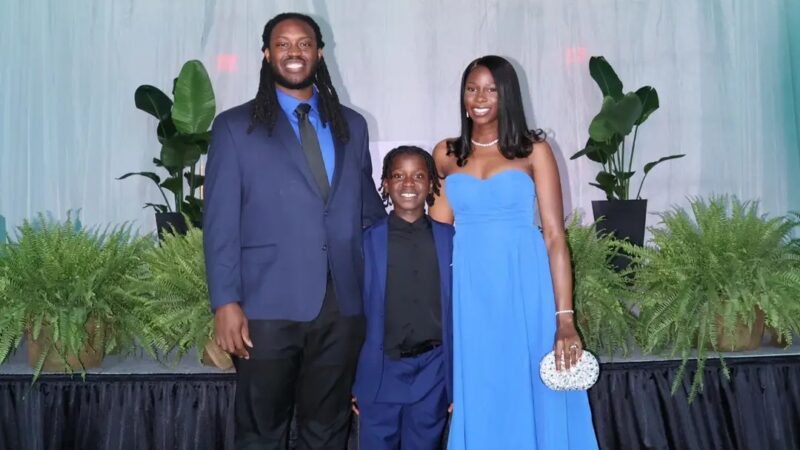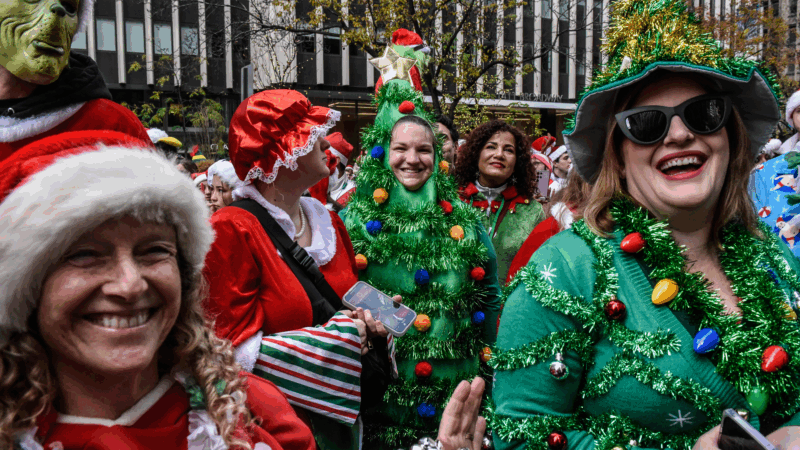D.C.’s Black Lives Matter mural will be erased. Look back at the iconic street painting
Washington, D.C.’s iconic “Black Lives Matter” street mural, which has served as a powerful symbol of activism and a gathering place for joy and resistance, will soon be gone.
The decision to remove the enormous mural near the White House comes after a U.S. Rep. Andrew Clyde, R-Ga., introduced legislation earlier this week that gave D.C. an ultimatum: either paint over the slogan or risk losing federal funding. The bill also called for the area in downtown D.C. to be re-named from Black Lives Matter Plaza to Liberty Plaza.
The next day, D.C. Mayor Muriel Bowser released a statement suggesting that the mural will have to go. “The mural inspired millions of people and helped our city through a very painful period, but now we can’t afford to be distracted by meaningless congressional interference,” she wrote. The DDOT confirmed on Saturday that plans to remove the mural will begin Monday.
The mayor’s response marked a reversal: She initially declared that the artwork would be permanent.

The mural was painted in 2020 after federal officers attacked D.C. protesters with tear gas
In June 2020, amid a nationwide outcry over the death George Floyd, who was killed by a police officer in Minneapolis, the mural was created overnight.
It was in direct response to reports of federal officers using tear gas against peaceful protesters in D.C.’s Lafayette Square. The demonstrators had been cleared shortly before President Trump walked through the park to St. John’s Church, where he posed for a controversial photo-op holding a Bible.
A few days later, the D.C. mayor commissioned a striking 48-foot-wide “Black Lives Matter” mural near the site of the altercation. The street painting spanned two blocks of 16th Street, just north of the White House. The mayor also renamed the area Black Lives Matter Plaza and designated it a pedestrian-only zone. In all, the project cost over $4 million.
“The symbolism is huge. We are saying it loud. We are here. Maybe you didn’t hear us before. Maybe you got confused. But the message is clear. Black lives matter, period,” Keyonna Jones, one of artists who helped paint the mural, told member station WAMU in 2020.
The mural’s unveiling fell on the birthday of Breonna Taylor, a Black medical worker who was killed in March 2020 during a botched raid by police officers in Louisville, Ky. “Breonna Taylor, on your birthday, let us stand with determination. Determination to make America the land it ought to be,” Bowser wrote on Twitter on June 5, 2020.
That same evening, Trump took to Twitter and called Bowser “grossly incompetent, and in no way qualified to be running an important city like Washington, D.C.” Later that night, Bowser posted a video of the mural and wrote, “We turned on the night light for him so he dreams about #BlackLivesMatter Plaza,” seemingly referring to Trump.
A place for protest, joy, mourning and where congressman John Lewis spent one of his final days
The plaza quickly became a popular meeting spot for demonstrations. People gathered or marched through, for an array of reasons including advocating for racial justice, promoting environmental justice, raising awareness of international issues and celebrating Juneteenth.



Many also came together to mourn the loss of civil rights leader and congressman John Lewis, who died in 2020. A year later, Bowser said that one of her proudest memories of the Black Lives Matter Plaza was when Lewis was able to see the street painting himself before his death.
“He recognized Black Lives Matter Plaza as good trouble, and we know it will remain a gathering place for reflection, planning and action, as we work toward a more perfect union,” Bowser said in 2021.


The installation has received some pushback over the years. After its inception, the D.C. chapter of Black Lives Matter called the mural “a performative distraction” by the mayor, accusing her of dismissing the chapter’s calls to defund the police and invest in the community.
On Friday, the group re-posted its initial complaints about the artwork and the mayor, adding, “We told you so.”
But, nationally, the Black Lives Matter Global Network Foundation condemned the decision to remove the artwork.
“First, they attacked critical race theory. Then, they banned books. Then DEI, Now they’re erasing Black Lives Matter Plaza. Big mistake. You can’t erase truth. Republicans hate that they have to walk past it. Hate that it reminds them of our power,” the foundation wrote in a statement.

Jones, who helped paint the mural five years ago, told WUSA9 that she understood the mayor’s decision and was proud of the impact that the mural made in its short run.
“It speaks for itself. People traveled the world to see this,” Jones said earlier this week.

Space Command is coming to Huntsville. What might that mean for first-time homebuyers
While Huntsville has been a more affordable market than other growing cities, what’s it been like for those looking for their first home?
Colorado says relocation of Space Command to Alabama is ‘punishment’ for mail-in voting
The litigation announced by Colorado Attorney General Phil Weiser asks a federal judge to block the move as unconstitutional.
Breaking down Alabama’s CHOOSE Act
It’s been a year since Alabama legislators passed the CHOOSE Act allowing families to apply for state funds to use towards homeschool expenses and tuition for participating private schools. The Alabama Daily News’ education reporter Trisha Powell Crain has been diving into how the funds are being used. WBHM’s Andrew Gelderman sat down with her to talk about what we’re seeing so far.
Huntsville is growing fast. Here’s how it’s stayed affordable
Home prices are rising in Huntsville, but so far, the city’s avoided the skyrocketing costs in other boom towns.
What are your unique holiday traditions? NPR wants to know
The holiday season is full of traditions and we all celebrate them a bit differently. NPR wants to your most unique holiday traditions. What makes celebrating this time of year feel special for you?
What are your unique holiday traditions? NPR wants to know
The holiday season is full of traditions and we all celebrate them a bit differently. NPR wants to your most unique holiday traditions. What makes celebrating this time of year feel special for you?









